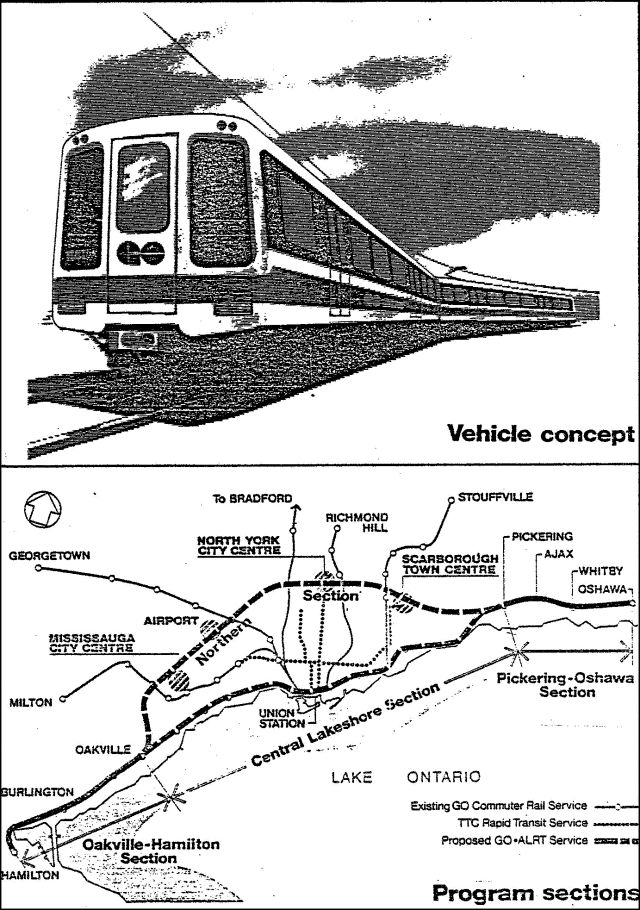A rapid transit fix for Toronto
Greg Gormick
In the quest to resolve the transportation problems bedevilling Toronto, our politicians and planners have proposed every solution except the most obvious one: greater use of our underused urban rail corridors.
While GO was expanded geographically after its launch on the Lakeshore Line in 1967, its growth rate has been glacial and inadequate funding has shackled it to an outdated, long-haul suburban service pattern. It provides only morning-in, afternoon-out weekday service to Union Station on all its rail lines except the Lakeshore, where there’s a paltry hourly service off-peak. Less appealing bus service fills the wide gaps elsewhere.
Just bulking up this bare-bones rail operation with more 10-car diesel trains would still leave serious flaws, one of which is that GO’s oversized trains fail to serve many transit-starved Toronto neighbourhoods. They are likely to remain so under Mayor Rob Ford’s expensive and geographically challenged subway scheme, which has replaced the broader and more affordable light rail transit (LRT) vision of former mayor David Miller.
What Toronto requires is the conversion of GO into an urban railway. The concept was born in 1924 with the creation of Berlin’s Stadtschnellbahn or S-Bahn — the world’s first “fast city railway.†The S-Bahn converted key suburban lines into a network that vastly increased urban transportation options and benefits.
The urban rail principles first proved on the Berlin S-Bahn include:
• High frequency, usually 5-10 minutes within the city and 15-20 minutes beyond.
• Extended service hours, running from approximately 5 a.m. until after midnight.
• Numerous stations within the city for short-haul trips.
• Dedicated tracks alongside those used for other passenger and freight trains.
• New line segments in tunnels or on the surface to strategically improve routings.
• Grade crossing removal to eliminate conflicts with road traffic.
• Electrification for rapid acceleration, elimination of fumes and cost-effectiveness.
• High-capacity electric multiple unit rolling stock.
• Integration with other city transit routes through a common fare system and connecting stations.
The Berlin S-Bahn became what has been described as a surface subway. This successful template has been applied in 14 other German urban regions, numerous cities throughout Europe and as far afield as Hong Kong and Sydney. The latest is London’s Overground, launched in 2007. Others will open in Brussels and Denver in 2016, followed by San Francisco.
Like these cities, Toronto possesses the rail corridors — many now owned by GO — to create an urban railway cheaper and faster than is possible with subways. It would mesh snugly with any new TTC lines that may get built, making direct connections with these and existing subway, streetcar and bus routes. Furthermore, its construction won’t snarl up great swaths of the city because the rail corridors are independent of the street grid.
Ontario’s regional transportation agency, Metrolinx, fleetingly endorsed an urban rail concept in its 2008 master plan, The Big Move. It called for “express rail†on GO’s Oshawa-Hamilton line and from Union Station to Brampton, Mississauga, Richmond Hill and Markham, to be built on a leisurely schedule of 25 years or more.
A Metrolinx study team has recently gone even further in response to a looming capacity problem. Population growth and increased travel demand will drive GO rail ridership to a level that will overwhelm Union Station within 20 years. Inspired by the urban railways of Madrid, Melbourne and São Paulo, Metrolinx has contemplated an electrified east-west GO tunnel somewhere between the existing rail corridor and Queen Street through the heart of downtown.
Vision such as this isn’t new in Toronto. In 1986, GO proposed expanding and realigning portions of GO’s Georgetown and Richmond Hill lines to provide high-frequency service from Malton to Union Station and up through Leaside and Don Mills to Thornhill.
The success of urban railways from Munich to Melbourne is proof of the tax dollars to be saved and the dividends to be reaped. Now’s the time for the creation of an electrified Toronto rail express — T-REX, to give it a brand name. Delay will only condemn Toronto to more gridlock, higher costs, lost productivity and increased car-fuelled environmental degradation.
Greg Gormick is author of the report No Little Plan: Electrifying GO Transit, commissioned by Transport Action, the Clean Train Coalition and the Canadian Auto Workers.







